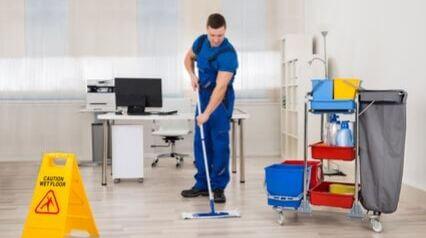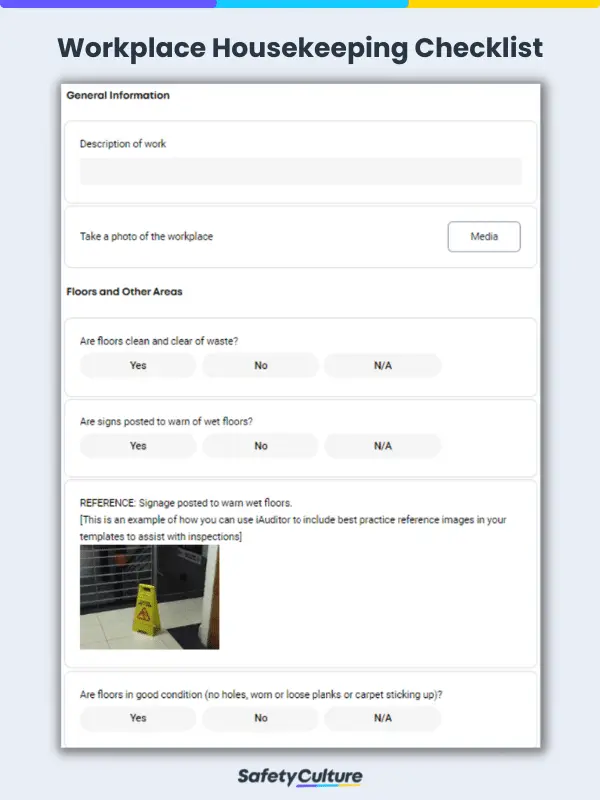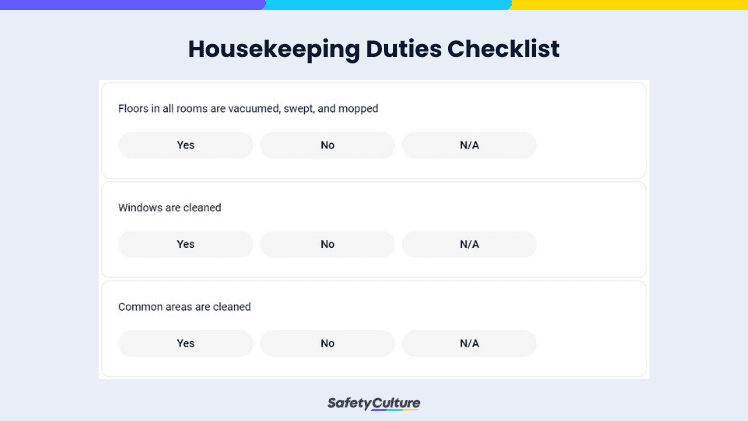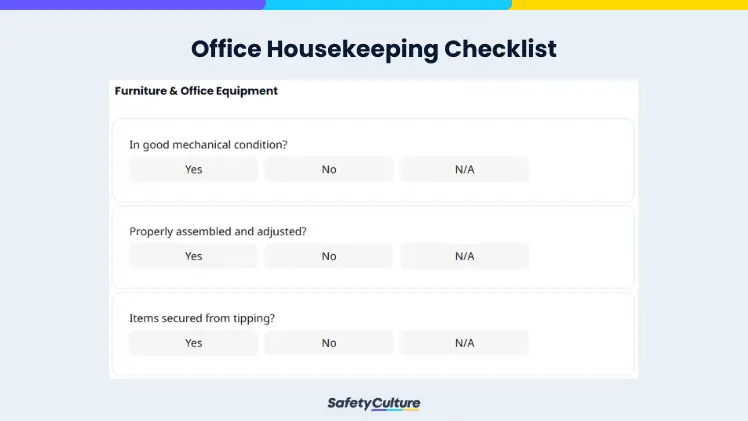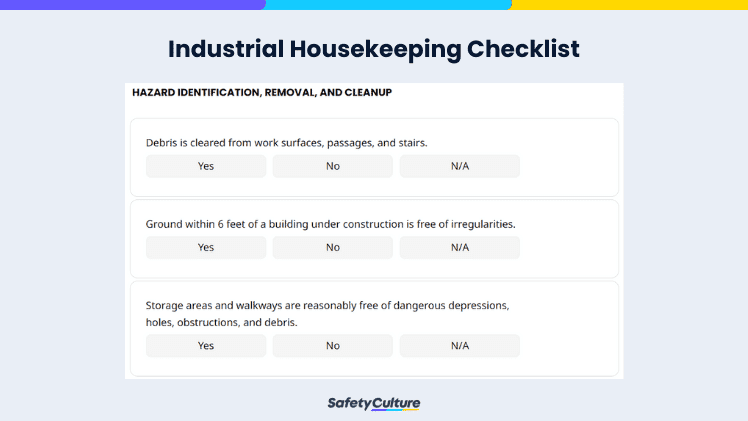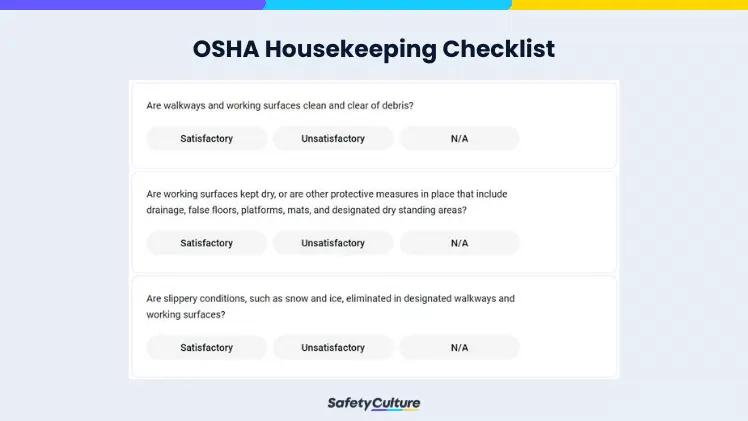What is a Workplace Housekeeping Checklist?
A workplace housekeeping checklist is a tool used to ensure that the workplace is well organized, hygienic, and safe for all employees. Good housekeeping prevents workplace hazards such as slips, trips, falls, and more. Regular housekeeping in the workplace also improves productivity, boosts morale, and helps employers avoid potential fines for non-compliance.
7 Standards of Housekeeping
The concept of 5s, along with two additional principles can be applied to promote good housekeeping in the workplace. The 7 rules of good housekeeping are as follows:
- Sort – All items should be neatly organized and all unnecessary items should be disposed of or removed.
- Set in order – All items should be placed in their appropriate locations. Assign labels and the appropriate labels.
- Shine – The workplace, tools, equipment, and machinery should be regularly cleaned. Broken or damaged items should be fixed.
- Standardize – The processes for the previous rules (sort, set in order, and shine) should be standardized and implemented across the business.
- Safety – Any visible hazards or risks should be removed from the vicinity of the workplace or at least be kept in appropriate locations.
- Spirit/support – The willingness as a group to establish an adequate implementation of the 7s standards of good housekeeping.
- Sustain – A monitoring system should be in place to continuously and consistently practice good housekeeping.
Example of Housekeeping Duties
A good example of a workplace where housekeeping is crucial in running the business is in the hospitality industry. The following are examples of housekeeping duties in hospitality:
- Floors in all rooms are vacuumed, swept, and mopped
- Windows are cleaned
- Common areas are cleaned
- Kitchen is cleaned and appliances, counters, sinks, and cabinet doors are wiped down
- Bathrooms are cleaned and supplies are re-stocked
- Trash is collected for recycling and disposal
- Furniture are cleaned and shined
- Linens are changed and re-stocked
- Spills are mopped right away
- Report any damage for possible repair
What to Include in a Workplace Housekeeping Checklist?
A comprehensive workplace housekeeping checklist should contain general but essential items that allow workplaces to extensively review and implement housekeeping best practices. This checklist can include the following items plus smaller elements under them:
- General information
- Floors and other relevant areas
- Aisles and stairways
- Spill control
- Waste disposal
- Equipment and machinery
- Storage area
- Fire prevention practices
- Completion
This can further be modified according to the liking and needs of the business. What’s important is that it can guide organizations in performing their housekeeping duties better and more efficiently.
How to Conduct a Workplace Housekeeping Inspection
To reach a significant and useful result in performing housekeeping inspections, workplaces should follow an organized and well-thought of process. To do this, try these three simple steps:
1. Prepare a workplace housekeeping inspection plan
Design a set of documents that details how the inspection should be executed. Ideally, this should include the name of the inspectors or authorized people assigned to the initiative. Adding the preferred inspection frequency from the get-go also helps establish consistency to ensure the plan’s effectiveness.
Additionally, listing down other tools to be used throughout the cycles of inspection would also be beneficial as there’s significant visibility for everyone involved.
2. Carry out the housekeeping inspection
Once a document has been prepared, a successful inspection should positively answer the following but not limited to questions such as:
- Are slips, trips, and falls prevented?
- Are air filters regularly cleaned and maintained?
- Are aisles and stairways cleared of possible hazards?
- Are spills controlled and managed in a timely manner?
- Are wastes disposed of and managed properly?
- Are equipment and machinery well-maintained?
- Are storage areas used appropriately?
- Are fire hazards and other related incident-causing factors eliminated?
If there are factors that particularly hinder proper workplace housekeeping, provide a solution for them with the next step.
3. Analyze the data
After each inspection, review the result and determine whether a workplace is at par with the current housekeeping standards that they have or if there are areas for improvement.
Take appropriate corrective actions, convey the changes to employees, and monitor their proper implementation to make sure that a desired result will be reached. The goal of housekeeping inspections is to continuously improve the way a workplace operates on a daily basis.
To establish the importance of routine workplace housekeeping inspections, consider leveraging tools that provide documentation, ready-to-use templates, and communication abilities all in one place.
Workplace Housekeeping FAQs
Workplace housekeeping refers to a set of activities taken to create a neat and orderly workplace. However, it doesn’t just refer to maintaining cleanliness. Workplace housekeeping also deals with keeping the workplace organized, uncluttered, and hazard-free.
Proper housekeeping is important in ensuring not only a pleasant but safe environment which the organization and employees benefit from. Workplace housekeeping helps prevent accidents, injuries, and illnesses by controlling and eliminating hazards.
Below are some examples of good housekeeping practices in the workplace:
- Regular maintenance of buildings and equipment
- Good organization of tools, equipment, materials, and even employee’s personal belongings.
- Regular collection, grading, and sorting of waste
- Wiping floors, walls, and other surfaces to prevent the accumulation of dust and dirt and harmful microorganisms that can cause illness.
